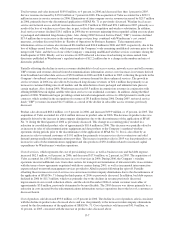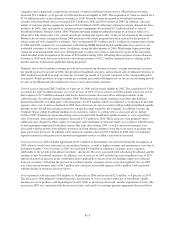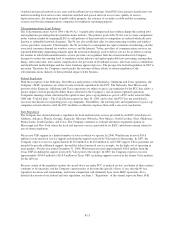Windstream 2006 Annual Report Download - page 113
Download and view the complete annual report
Please find page 113 of the 2006 Windstream annual report below. You can navigate through the pages in the report by either clicking on the pages listed below, or by using the keyword search tool below to find specific information within the annual report.Local service revenues consist of local exchange telephone services provided to both residential and business
customers, including monthly recurring charges for basic services such as local dial-tone and enhanced services such as
caller identification, voicemail and call waiting, and non-recurring charges for service activation and reconnection of
service. Local service revenues increased $13.3 million, or 1 percent, in 2006 and decreased $34.1 million, or 3
percent, in 2005. The acquisition of Valor accounted for a $68.5 million increase in local service revenues in 2006.
Local service revenues in both periods primarily reflected reductions consistent with the overall decline in access lines
discussed above. In addition, the decline in local service revenues in 2006 reflected reductions in expanded calling area
rate plans of $14.1 million. As further discussed below, the Company has begun offering new long distance rate plans
in select markets, which has induced customers to move from expanded calling areas to unlimited long distance calling
and has resulted in increases in long distance revenues. The decline in local service revenues in 2006 was also the
result of discounts provided to customers who elected a bundle of services. These discounts are applied to
non-regulated features included in the package such as voice mail and caller identification. Conversely, the decline in
local service revenues in 2005 attributable to access line loss was partially offset by growth in revenues derived from
the sales of those features and equipment protection plans. Revenues from these services increased $3.6 million in
2005, reflecting continued demand for these products and services.
Network access and interconnection revenues include switched access, special access, end user charges and receipts
from federal and state USF. Switched access represents usage sensitive charges to long distance companies for access
to our network in connection with the completion of interstate and intrastate long distance calls. Special access
represents dedicated circuits, including circuits used to provide broadband service, while end user charges are monthly
flat-rate charges assessed on access lines. Network access and interconnection revenues increased $103.5 million, or 10
percent in 2006, and decreased slightly in 2005. The acquisition of Valor accounted for a $119.6 million increase in
network access and interconnection revenues in 2006. Primarily due to the overall decline in access lines discussed
above, network access usage and toll revenues decreased $30.7 million in 2006 and $42.8 million in 2005. Partially
offsetting the decline in network access and interconnection revenues in both periods due to access line loss was the
growth in revenues earned from data services, which increased $30.1 million and $26.0 million in 2006 and 2005,
respectively. The growth in revenues from data services in both 2006 and 2005 primarily reflected increased demand
for high-speed data transport services. In addition to the effects of access line loss and increased demand for data
services, federal and state USF funding decreased $15.4 million in 2006 and increased $12.5 million in 2005,
respectively. Windstream receives both federal and state USF subsidies due to the rural nature of most of its regulated
markets. The decrease in USF revenues in 2006 resulted primarily from a decrease in the high-cost loop support
(“HCLS”) funding received by our regulated subsidiaries. The decreases in HCLS funding primarily resulted from
increases in the national average cost per loop combined with the effects of our cost control efforts. Receipts from the
HCLS fund are based on a comparison of each company’s embedded cost per loop to a national average cost per loop.
Primarily due to expected increases in the national average cost per loop and our continued focus on controlling
operating costs in our regulated business, we expect net federal and state USF receipts in 2007 to decline by
approximately $15.0 million, compared to 2006. The increase in USF revenues in 2005 resulted primarily from an
increase of $13.3 million in interstate common line support (“ICLS”) funding received in our rate-of-return markets as
a result of the declining subscriber access revenues discussed above. ICLS funding is intended to ensure that
rate-of-return carriers receive sufficient revenues to earn an appropriate profit margin, defined as 11.25 percent of
eligible costs.
Long distance revenues primarily consist of per minute and recurring charges for placing interstate and intrastate long
distance calls. Revenues derived from long distance services increased $38.6 million, or 21 percent, in 2006. The
acquisition of Valor accounted for a $16.6 million increase in long distance revenues in 2006. The increase was
primarily driven by new rate plans initiated in various markets during 2006 that provide packages of minutes or
unlimited minutes of long distance services for a flat monthly recurring charge and an increase in customer billing rates
in all markets initiated during October 2006. In response to competitive pressures, the Company continues to introduce
long distance rate plans in its markets that provide customers with various billing options. Revenues attributable to
long distance services increased $6.3 million, or 4 percent, in 2005, primarily due to an increase in customer billing
rates initiated during the second quarter of 2005 on one of our most popular billing plans. In both years, the increases
were partially offset by a decline in usage charges resulting from the effects of customers migrating to the packaged
rate plans previously discussed.
Miscellaneous revenues primarily consist of charges for the non-regulated portion of broadband services, directory
advertising, customer premise equipment sales and rentals, billing and collection services provided to long distance
F-12
























